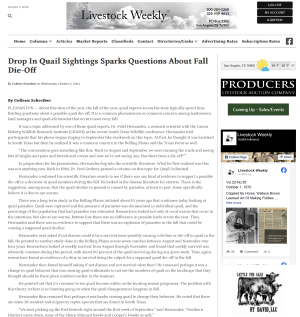
Drop In Quail Sightings Sparks Questions About Fall Die-Off

PLEASANTON — About this time of the year, the fall of the year, quail experts across the state typically spend time fielding questions about a possible quail die-off. It is a common phenomenon or common concern among landowners, land managers and quail aficionadas that occurs most every fall.
It was a topic addressed by one of those quail experts, Dr. Fidel Hernandez, a research scientist with the Caesar Kleberg Wildlife Research Institute (CKWRI), at the recent South Texas Wildlife conference. Hernandez told participants that his phone begins ringing in September like clockwork on this topic. At first, he thought it was localized to South Texas but then he realized it was a common concern in the Rolling Plains and the Trans Pecos as well.
“The conversation goes something like this, ‘Back in August and September we were running the roads and seeing lots of singles and pairs and broods and coveys and now we’re not seeing any. Has there been a die-off?’”
In preparation for his presentation, Hernandez dug into the scientific literature. What he first realized was this was not anything new. Back in 1984, Dr. Fred Guthery penned a column on this topic for Quail Unlimited.
Hernandez continued his scientific literature search to see if there was any kind of evidence to support a possible die-off or a decrease in quail numbers during the fall. He looked at the disease literature for starters. There is the suggestion, among some, that the quail decline in general is caused by parasites, at least in part. Some specifically believe it is due to eye worms.
There was a long-term study in the Rolling Plains initiated about 10 years ago that continues today looking at quail parasites. Quail were captured and the presence of parasites was documented in individual quail, and the percentage of the population that had parasites was estimated. Researchers looked not only at cecal worms that occur in the intestines, but also at eye worms. Bottom line there was no difference in parasite loads across the year. Thus, Hernandez said there was no evidence to support that there was an explosion of parasites in the fall that could be causing a supposed quail decline.
Hernandez next asked if not disease could it be a survival issue possibly causing a decline or die-off in quail in the fall. He pointed to another study done in the Rolling Plains across seven ranches between August and November over four years. Researchers looked at weekly survival from August through November and found that weekly survival was relatively constant during this period, with about 90 percent of the quail surviving during any given week. Thus, again, researchers found no evidence of a drop in survival being the culprit for a supposed quail die-off in the fall.
Hernandez then found himself asking if not disease and not survival what then? He reasoned perhaps it was a change in quail behavior that was causing quail enthusiasts to not see the numbers of quail on the landscape that they thought should be there given numbers earlier in the summer.
He pointed out that it’s common to see quail become wilder as the hunting season progresses. The problem with this theory is there is no hunting going on when the quail disappearance happens in fall.
Hernandez thus reasoned that perhaps it was hawks causing quail to change their behavior. He noted that there are some 28 resident and migratory raptor species that are found in South Texas.
“We start picking up the first Kestrels right around the first week of September,” said Hernandez. “Northern Harriers move down, some of the Sharp-Shinned hawks and Cooper’s Hawks as well.”
He queried whether this influx of hawks during this time of the year could be causing quail to move into the denser wooded areas and away from the roads where they’re easier to spot. Though there are not any statewide quail surveys done at this time of the year, CKWRI’s Quail Associates, some 20 properties spread throughout South Texas, conduct repeated roadside surveys from August through September, with four to six surveys on any given property.
This information of repeated surveys enables CKWRI quail scientists to estimate the detection probability of quail along roads. They found that the detection probability of quail decreases over time. However, they don’t know for sure what’s causing that detection change.
“It could be changes in the habitat structure. It could be quail moving away from the roads. We just don’t know,” Hernandez told the group. “What we do know is that detection probability goes from 50 percent at the start of August to about half of that right around the start of October. So just by this alone, we’re seeing less quail along the roads by October.”
Another possibility as to why fewer quail are seen at that time of the year is the change in social structure. During the summer, reproduction is occurring, he reminded. Chicks are hatching, and it’s not uncommon to see singles, pairs and broods.
In the fall quail begin to covey up. In one’s mind, going from seeing maybe 20 individuals to seeing one or two coveys might change one’s perception about how many quail are on the landscape.
“This was what Fred Guthery thought was happening,” said Hernandez.
Basically, what Guthery showed was that the spacing among coveys doesn’t change much when talking about one quail to the acre or three quail per acre. However, the spacing changes dramatically when density goes to one quail per two acres.
“With this small change in density, that spacing changes dramatically from about 400 or so yards per covey to about 800 yards,” said Hernandez. “There’s been no die-off. It’s just how spacing and covey size grouping occurs that gives the appearance that there are fewer quail on the landscape.”
Lastly, Hernandez told participants that this phenomenon of fewer quail or a die-off of quail in the fall could simply be human memory.
“The good ol’ days are always much better in our minds than what they actually were,” he quipped. “It’s just the way we think.”
Hernandez pointed to some research done by neuroscientists that supports a version of this. In this case, in a courtroom setting an eyewitness remembers something one way and three months later that eyewitness may recall it differently.
“Most of us think that memory is like a videotape that it’s fixed. We see something, and it stays in our mind,” said Hernandez. “It doesn’t.”
He also pointed to work done by neuroscientist Hermann Ebbinghaus who in the late 1800s developed the forgetting curve. He essentially found that, after something is read, only about 50 percent of what was read can be recalled after a 24-hour period and after seven days only about 20 percent of what was read is remembered.
“Not only is there memory information loss, but there is also memory distortion over time.”
Hernandez concluded that there is nothing to support this phenomenon or idea that appears to occur every single fall, to suggest that there is a quail die-off or that there are indeed drastically fewer quail on the landscape at the start of the hunting compared to earlier in the year.
“It can happen; die-offs occur, but not consistently every fall. It’s more likely due to a change in social behavior and or also our human memory. Things just aren’t as rosy as we recall,” he concluded.